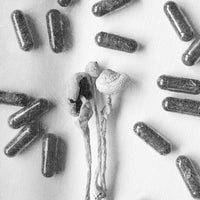Eighteen years ago, when Nandita Godbole was nursing her newborn, her mother gave her an Ayurvedic tonic made from the herb ashwagandha (Withania somnifera). “Although it helped a little early on, I did not use it enough to see long-term benefits,” says Godbole, a chef and author based in Atlanta, Georgia.
Fast-forward to 2019 and Godbole decided to use the herb again when she was facing health issues caused by severe anemia. “I came across ashwagandha-centered herbal cures in easier-to-take forms like powders and pills. I had to undergo emergency surgery to address the problem—there was no time for a slow herbal cure. But when I was in recovery, I returned to exploring the health benefits of many fruits and herbs, including ashwagandha,” she tells Trends w/ Benefits.
Godbole’s own journey of healing inspired her to write Seven Pots of Tea: An Ayurvedic Approach To Sips And Nosh which was published at the end of 2020. The book also has a unique recipe featuring the herb. “It seemed only fitting to create a beverage that would allow readers to enjoy ashwagandha safely. The ashwagandha blueberry green tea is not only pretty to look at; readers find it quite tasty thanks to the blueberries and lemon,” she says.
Ashwagandha is a shrub that grows in dry subtropical regions in Asia and Africa, where it has been used as a medicinal plant for hundreds of years. In Asia, it grows in India, Sri Lanka, Pakistan, Afghanistan and China. Its name is made up of two Sanskrit words—ashwa meaning “horse” and gandha meaning “smell.” While some say this name comes literally from the horse-like smell the herb emits, others say that it symbolises the strength of a horse.
In recent years, ashwagandha has gained popularity in the U.S. and ashwagandha moon milks are currently trending like turmeric milk lattes did a few years back. But does this superherb have any real benefits? To understand, we must first dive into the history and origins of ashwagandha.
Where Does Ashwagandha Come From?
Ashwagandha has been used in traditional medicine systems such as Ayurveda, Unani, Siddha, Sowa Rigpa, homeopathy and other folk medicine models. It is as old as Ayurveda itself, which is believed to be 5,000 years old. Ayurvedic experts say that detailed information about ashwagandha is present in all the three generations of Ayurvedic texts.
That being said, the origins of the plant are unclear. “We can definitely believe that ashwagandha originated in India or Asia because most of the Ayurvedic texts cover the geographical area of India or the Sindu (the Indus river),” says Dr. Gopakumar S, professor at Government Ayurveda College in Kannur, Kerala, southern India.
Ayurvedic experts claim that the earliest mention of the herb is found in the Charaka Samhita, a foundational medical text written by Ayurvedic practitioner Charaka, who lived between 200 B.C. and 200 A.D. “In the book, ashwagandha features as an ingredient in various drug formulations for treatment of skin, respiratory, rheumatic, pediatric and debilitating conditions,” says Dr. Jithesh MK, physician at Arya Vaidya Sala.
In Unani medicine, the origins of which lie in ancient Greece, Withania somnifera is called asgandh. “This plant was grown in Greece and the Middle East and is mentioned in many old Unani books to treat aging, stress and improve fertility,” says Dr. Syed MM Ameen, a Unani doctor based in Chennai in the southern Indian state of Tamil Nadu.
Al-Razi, a Persian physician from the medieval times wrote about the uses of asgandh in his books. His contemporary physician Ibn Sina also wrote about the herb in his book Kitab Al-Qanun fit-Tibb (The Canon of Medicine). In 1984, the Indian government published a National Formulary of Unani Medicines which standardised drug formulations made with many herbs, including asgandh. Read more: The History and Origins of Masala Chai
Read more: The History and Origins of Masala Chai
The Properties and Traditional Uses of Ashwagandha
Ashwagandha is a herb of major importance in one of the branches of Ayurveda called rasayana chikitsa, which focuses on rejuvenatory treatments. “Ashwagandha is a very popular rasayana drug. Rasayana drugs enhance tissue vitality. Ashwagandha is used to build stamina, vitality, immunity and endurance. In another branch of Ayurveda called vajikarana chikitsa, the herb is also used to treat infertility, impotence and improve sexual performance,” says Dr. Gopakumar.
Ayurvedic experts say ashwagandha is an anti-stress, immuno-stimulatory and brain-nourishing drug that is useful in treating neuro-muscular diseases like Parkinson’s, Alzheimer’s and dementia. It is also combined with other drugs to treat diseases of the liver, joints and the urinary system.
Sharngadhara Samhita, a text from the 14th century, contains detailed information on how to prepare drug formulations such as kashaya (water-based decoction or extract), lehya (thick syrup), churna (powder) and ghee (clarified butter) from ashwagandha. Bhava Prakash Nighantu, written by Bhavamishra in the 16th century, says that ashwagandha is astringent and bitter in taste and pacifies vata and kapha, two of three kinds of doshas or body constitutions in Ayurveda. “It is useful in disorders of the nervous system, secretory disease, leprosy, edema and inflammatory diseases,” says Dr. Adarsh Kumar, former head of the Government Ayurvedic College and Hospital in Patiala, Punjab in northern India.
The Evolution of Ashwagandha as a Modern-Day Superherb
The last decade has seen the emergence of a vast range of products containing ashwagandha. So how did a herb restricted to alternative medical pharmacies find its way into the health and wellness industry? This growth can be attributed to the growing research on ashwagandha in the last decade-and-a-half.
Dr. Sunil Kaul is a Senior Scientist at the National Institute of Advanced Industrial Science and Technology (AIST) in Tsukuba Science City, Japan. He studies the molecular mechanism of stress, aging and cancer, and their intervention by natural compounds. In 2004, his team began research on ashwagandha and tested the leaves, stems and roots of the plant in search of their bioactive ingredients. They found that the leaves have a high amount of withanolides.
“We generated a variety of extracts and reported that the alcoholic extract of ashwagandha leaves possessed selective cancer cell-killing activity. We also saw in our studies that its ingredients could protect normal cells against a variety of stresses. Such effects may account for its side benefits in contrast to the side-effects of conventional chemotherapeutic drugs,” says Dr. Kaul, who co-authored Science of Ashwagandha: Preventive and Therapeutic Potentials, as well as many research papers on the potential of the herb as a botanical drug.
Currently, AIST in Japan and the Indian government are doing extensive research on ashwagandha’s potential in the treatment of cancer, stress, sleep and neurological disorders, and enhancing the quality of life. In 2017, AIST conducted a study in collaboration with Tsukuba University, Japan and found that the triethylene glycol, an active component of ashwagandha leaves, induces sleep. Dr Kaul believes it might be useful in improving sleep for elderly people and those undergoing radiotherapy.
While the usage of ashwagandha has certainly evolved to meet our modern day needs, Ayurvedic doctors still stick to traditional formulations. “In the classical Ayurvedic texts, the powdered root of ashwagandha was used. The normal prescription was five to 10 grams of the powder with milk or other forms of medicine. In these times of COVID, ashwagandha powder, tablets and capsules are available in the global market to improve immunity. It is also an important ingredient in so many Ayurvedic anti-stress drugs that are being sold,” says Dr. Gopakumar.
The Future of Ashwagandha
Can the growing demand of ashwagandha affect its availability in the future? “There can be a huge raw material scarcity. It might become hard to find in shops. As its usage increases, its cultivation also needs to increase,” says Dr. Jithesh. And will an increase in demand have an impact on the quality of ashwagandha that enters the market? “We have to be very careful while using ashwagandha. No two ashwagandha plants are the same. It has to be grown in a clean, controlled, uniform and organic way to retain its chemical composition, which in turn, will ensure its efficacy. If a company is using ashwagandha, they have to do their research and background checks to ensure quality control, ” says Dr. Kaul.
While there is not a lot written about ashwagandha in modern literature, its numerous healing properties mentioned in historical medical texts have inspired laboratories to explore its potential for treating some of the deadliest diseases in the world such as cancer. As awareness about the benefits of ashwagandha grows in the post-pandemic world, it only seems likely that more people will turn to it for a stronger, well-rested and active body.




